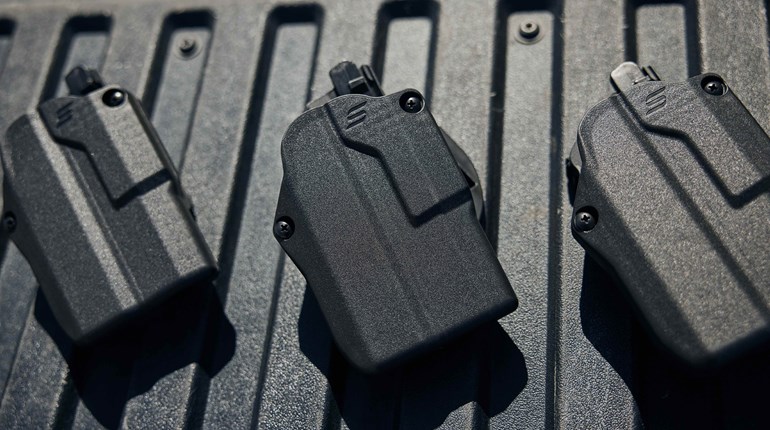
No folderol or embroidery this week, folks: We put three vastly popular single-stack, striker-fired, polymer-framed 9 mm carry pistols through our ringer—and our subsequent results in one spot. If you’re cogitating an M&P Shield, M&P Performance Center Shield or Glock 43, we hope it helps. We’re reshooting them for “First Gear,” having reviewed them before. But our bloom-is-off-the-rose, side-by-side brawl had a few surprises nonetheless. Feature by feature, here’s our take:
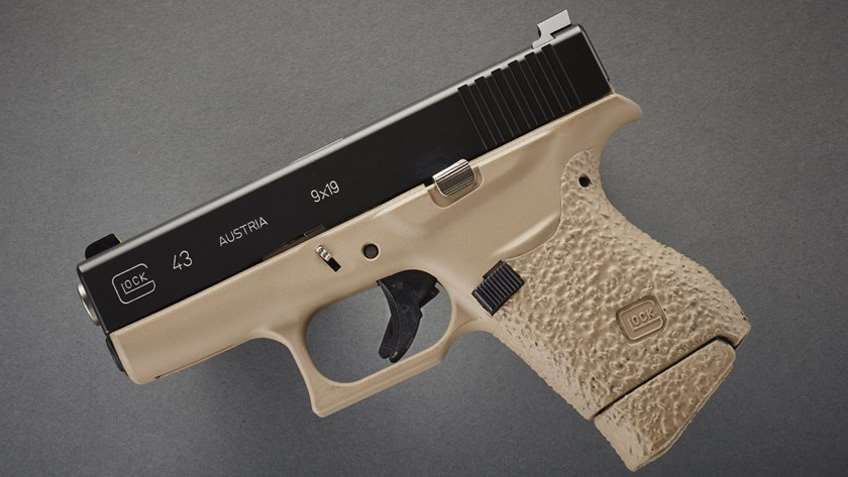
Sights
We’ve become haters—of black-on-black sights, that is, and white three-dots are only a tiny improvement. We put the best of these on our pistols for decades (mostly BoMars and Novaks), and inventively modified where no such options were available. But they simply do not compare with modern choices/materials/technologies. And for superb proof you need look no further than those S&W chose for the PC Shield—HiViz fiber sights.
Here, the PC Shield wins in a walk-off, as the other two are variations on themes that time and technology have simply bypassed. Don’t berate manufacturers too harshly in this regard: These low-end solutions work, after all, and either Glock or Smith would have a devil of a time picking something everyone would like. There is good news for our lesser combatants: Newer technology (like night sights) can be added with ease, or even duplicate the HiViz pairing.
The Performance Center kit is a bit of a gamble in this sense, but a good one. It’s nice to have good sights at the outset, so as we said—advantage Performance Center Shield.
Accuracy
This is easy: For shorty guns, all three were absurdly accurate. In a hurry, we think the utterly unmistakable red fiber of the HiVizs on the Performance Center Shield constitutes an edge, but this does not speak to accuracy per se. Combined with the flatter recoil provided by the muzzle porting (see below), this is lots of fun, and even a little impressive with practice. At distance, we had to find an adjusted point of aim, but it was at least consistent. We thought regulation on the Glock sights was noticeably better, especially after we put some Trijicon HDs aboard: On deliberate shots at absurd distances—40 to 50 yards—we hit best with the G43.
The standard Shield was tougher because its sight picture is the weakest, but we had no sense at all that it was less accurate. When a proofed sight picture and trigger break coincided, it too put shots just where we wanted them to go.
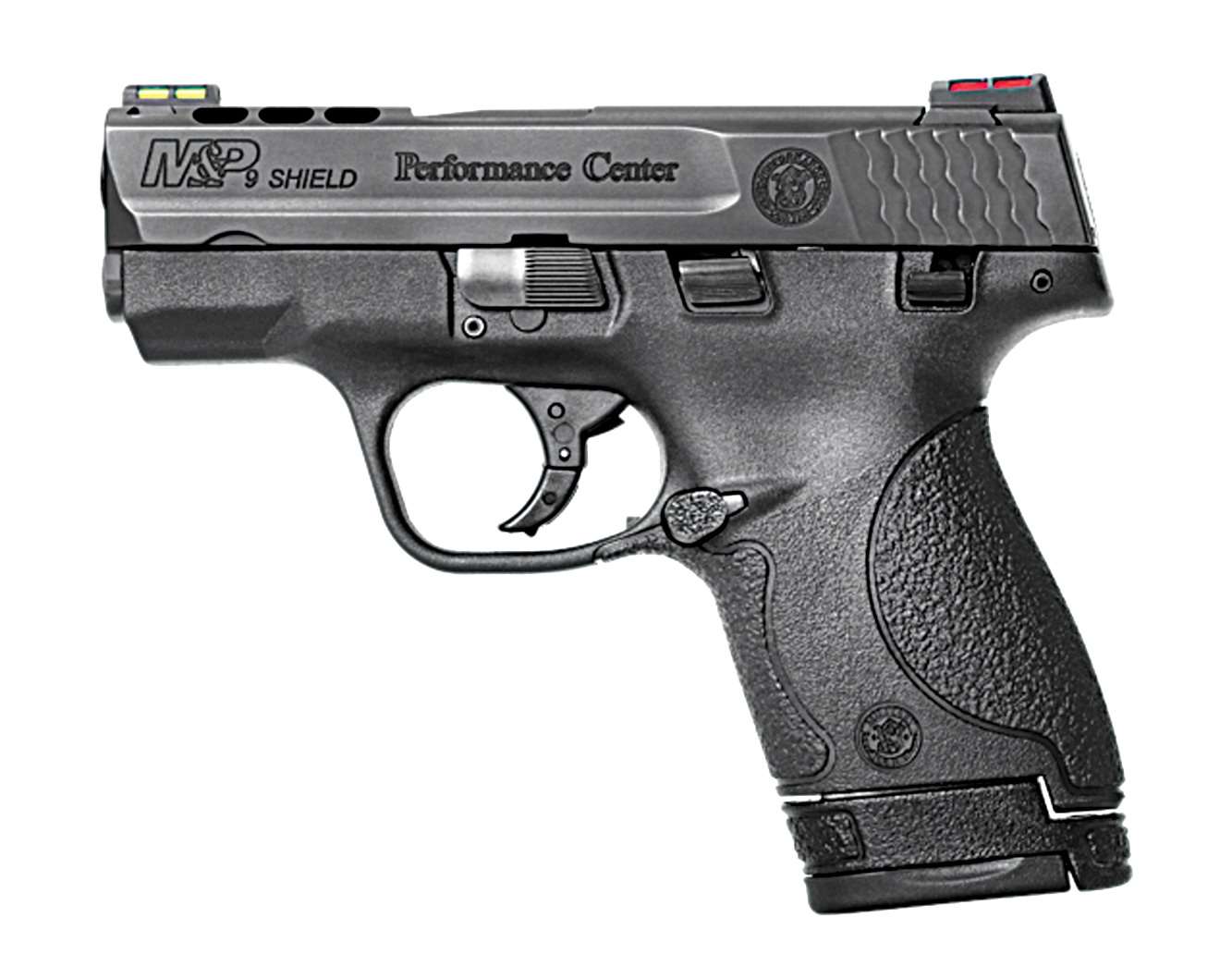
Trigger
For reasons we are quite prepared to own—that is, we recognize them as a preference—we’re not huge fans of the M&P trigger architecture. We’re not saying it’s bad, just that it seems less well suited to our “architecture.” Still, this annoyance is least on the Shields compared to the full-size models, and all but vanishes on the Performance Center-tuned version. Two syllables will suffice—“yee” and “haw!” With even a little practice, we found we could run the PC pistol nearly as rapidly as a full-sized gun (with proper technique; try this) due to the sear and plunger hand-fit that every Performance Center gun receives.
The G43 is in between the Shields as it arrives in the box. The PC trigger is lighter/better due to the hand tune of trigger components, but still has the overall geometry issue that leaves us slightly preferring the Glock.
If you give the Glock a parts upgrade like this from Ghost, Inc. that essentially catches up to what the Performance Center gun starts with, then choosing really devolves to a matter of taste. Tuned Smith vs. tuned Glock is actually easy to describe, too: The PC Smith has a longer take-up, slightly mushier break, but nice short reset, while the G43 has shorter take-up, more positive break, but longer reset.
So advantage, though slight, is to the PC Shield. We think you’ll have a hard time choosing a regular Shield compared to either of the other two.
Ported Muzzle
Don’t kid yourself; this is no gimmick. It’s a technology that’s actually been around for ages, just very rarely applied to small pistols. The base Shield lacks these, and the Performance Center version has them. The first is a shootable small pistol with a typical, challenging-to-control muzzle; the second is a small pistol that stays so flat in recoil that exercises like the plate rack will rival your big-gun times. ‘Nuf said?
The G43 part of this comparison, however, isn’t as lopsided as you might think, given that it has no ports. It’s noticeably quieter in our hands than the standard Shield, and a lower bore line keeps it closer to the Performance Center pistol than you’d expect, despite the S&W’s advantage of ports.
Here, a small sidebar: On a defensive gun, there’s a long-standing argument that ports are overly (if only temporarily) hard on night vision, and should therefore be eschewed. We had a chance to shoot these in the dark, and we just don’t, ahem, see it: Between proper target ID—usually using a bright tac flashlight and the muzzle flash of a short-barreled pistol—our night accommodation was shot, so to speak, anyway on all three pistols. While the difference is visually apparent—and kinda cool in favor of the ported Shield—we didn’t notice a lick of difference in our remaining level of darkness accommodation.
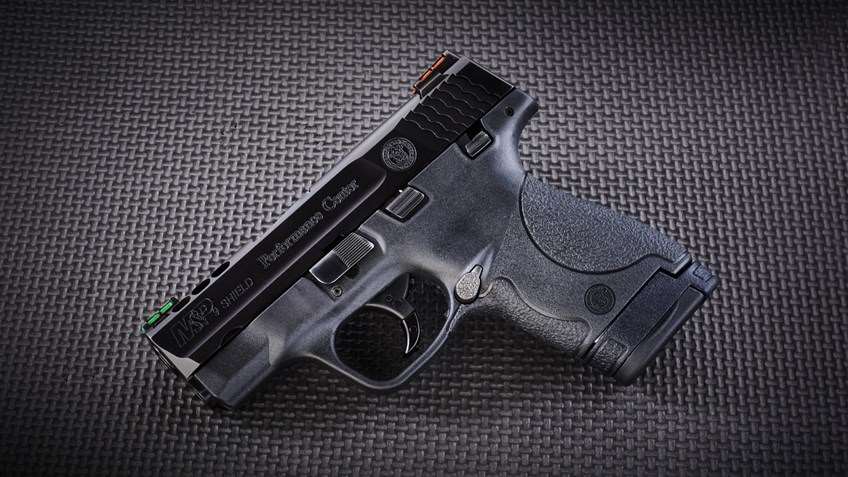
Reliability
This one is easy: Glock, though in fairness some clarification is required. The original Shield is fine with middling weight bullets—the common ones—but did best with noticeably “oomphy” loads. Lighter bullets with (usually) shorter OALs performed poorly unless they were operating at +P-ish power levels, and 147s and 158s were on-again, off-again affairs. Sometimes an entire box would run, other times, a single magazine would not. The porting of the Performance Center gun had the potential to complicate this picture even more, but we didn’t find it so. It’s a subjective impression, but it seemed to us that the PC Shield was always better than the standard gun, and in our original testing sessions we didn’t have a single malfunction.
The difference appeared for our “First Gear” shooting with what we’d call “soft” factory—those boxes or lots that sometimes enter the supply chain with no notice that they’re 5, 8 or 10 percent softer than normal due to component variability at the manufacturing level.
This is where Glock’s different solution—whatever it might be in terms of the balance between barrel length, recoil spring, bore diameter, and many other engineering minutiae—gave a pretty clear advantage. We had to fabricate rounds to find ammo that wouldn’t run. It is important that we don't overstate this, however: especially in comparison to several generations of predecessor pistols large and small, all three of our test guns would qualify as "extremely reliable." Just make sure the ammo you select works in your gun-don't rely on recommendations, however august the source.
Magazines
All three of these come with good quality magazines, though the Shields have a seven- and eight-rounder (the latter helpfully adding 3/4 inch to grip length), and the Glock “standard” is two six-rounders—one with pinky support, one without. The edge here goes to the M&Ps. Granted you can add length to G43 mags, as well as round count, through a host of mechanisms, and we’d recommend it. We think some addition is worthwhile on all three if it gives a place to park the pinky finger more securely.
A “comfort” note relates to magazines: As with the full size M&Ps, Shield magazine lips are surprisingly sharp and mag springs strong. Especially when new, some kind of loader is recommended, or you’ll have sore thumbs at the end of your first few practice sessions.
Reloads are problematic on all three because of the way the guns ride in the average-sized hand: “Drop-free,” as the saying goes, just ain’t happenin’. Good speed is possible, though only as the result of a technique adjustment. Happily, this works equally well on all three guns, and will be the subject of an upcoming “Carry Life” column.
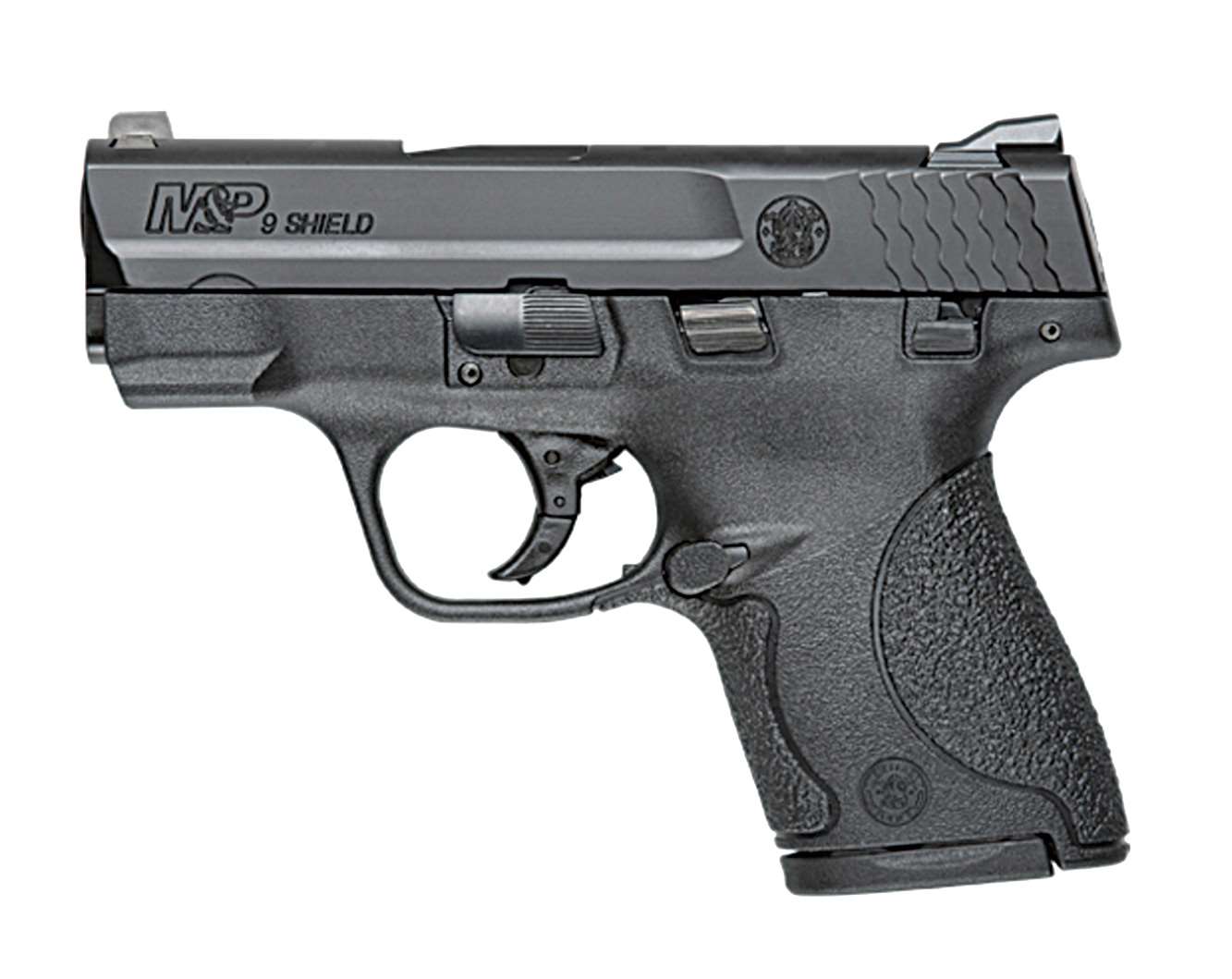
Grips
We’re fans of the many recent attempts to make grip structure more accommodating. It’s a substantial aid to greater comfort and control, as well as to safety. Small pistols, naturally, are a more complicated challenge: Along with smaller grip dimensions, lighter firearm mass and stiffer springs tend to make them feel disproportionately “bucky” and cramped. They’re consequently harder to shoot no matter who produces them, and swappable grip components don’t appear on either of the Shields or the G43.
Though grip materials are much the same, they exhibit slightly different design philosophies. The Shields use more three-dimensional contours and alternate the surface treatment—some areas/panels are smooth, others pebbled. The G43 is flat-sided, and uses the same truncated mini-pyramids as their Gen4 pistols. Both were fine in our hands.
A small knock goes the direction of the Shields here on a different count: The more elliptical shape of the Shield grip at the rear was not as comfortable in longer evaluation sessions when heavy/defensive loads were in play. The Glock geometry is less complex and elaborate looking, but in this case, more effective at spreading out heavier recoil.
We wish we had better news in our last two assessment categories, namely, a definitive winner. In terms of shootability and concealability, we think the Performance Center Shield and G43 handily edge the none-PC Shield, but that’s as far as we would go.
We shot our Performance Center Shield and G43 head-to-head in a match (Steel Challenge), alternating carefully, and optimizing ammunition in each, hoping for a clear victor. No joy: On the shots where extremely rapid recovery was crucial, the ports on the PC Shield were a reliable advantage. But as targets marched away, the better sight regulation and cleaner trigger break tipped back toward the G43.
In terms of concealability, both pistols are strong. Loaded weights are within an ounce, allowing for capacity, and length/width dimensions within a half-inch. Pressed, we observe that the Glock is less “square,” which we think generally makes discreet carry slightly easier, though the Shield is thinner.
As is so often the case with modern pistols from top-of-the-line manufacturers, choosing is difficult. The only way to be sure is shoot them both before you buy—and preferably more than once.
We have a lot of confidence in both, and are energetically soliciting inventive excuses for delaying the return of our demos.











